What does media coverage of the general election campaign and the Grenfell Tower fire tell us about what Theresa May might expect as she faces her most difficult week as Prime Minister?
Britain is heading into one of the most politically uncertain weeks in its modern history. Wednesday’s Queens’ Speech – or, as it’s been described, the Queen’s Haiku, since it’s not expected to be particularly lengthy – will open what’s now a two-year parliamentary session, extended to facilitate the Brexit negotiations.
Meanwhile, the reality of that particular conundrum starts to bite today when UK and EU negotiators meet in Brussels for their first session.
The coming days will be a difficult period for the Prime Minister, weakened by the failed gamble of the general election and still trying to recover from her damaging optics in the wake of the terrible fire at the Grenfell Tower block. Added to this is continued public anxiety over the wave of recent terror incidents in Manchester, London Bridge, and last night at Finsbury Park.
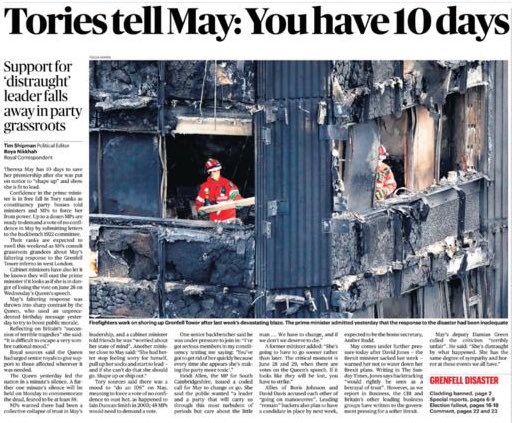 More than ever, Mrs May needs all the friends she can get, but among those she can probably no longer count on are the traditionally right-wing newspapers which enthusiastically endorsed her and relentlessly promoted her cause – and her “strong and stable” personality – during the election campaign.
More than ever, Mrs May needs all the friends she can get, but among those she can probably no longer count on are the traditionally right-wing newspapers which enthusiastically endorsed her and relentlessly promoted her cause – and her “strong and stable” personality – during the election campaign.
Yesterday, the Sunday Times reported on Conservative unrest, saying that the Prime Minister has “ten days to save her job” and warning of “up to a dozen MPs” ready to demand a vote of no confidence.
One of the most revealing tweets of a remarkable election evening – was it really only just over a week ago? – was from the former Labour deputy leader John Prescott, who wrote: “Heard from a very good source who was there that Rupert Murdoch stormed out of The Times election party after seeing the exit poll.”
Not only did that (subsequently disputed) tweet give us a clue that maybe the result was going to be more interesting than we’d thought, but it was an image that summed up the frustration of a media that had gone all in for a flawed and under-performing candidate.
Murdoch’s Sun, for example, in an echo of its famous 1992 election day front page against Neil Kinnock, used a similar graphic appeal to readers to reject the current Labour leader.
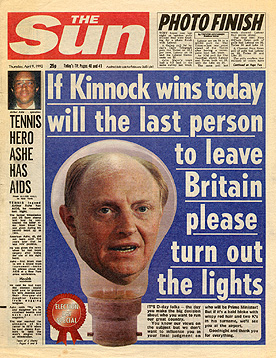
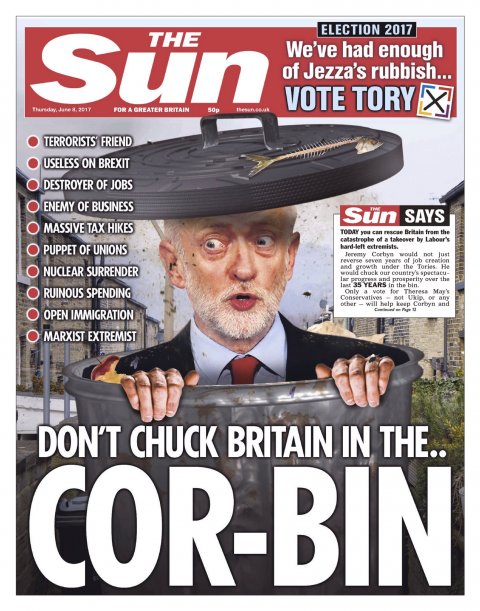
This time, though, it wasn’t the “Sun wot won it” – despite its apparent obsession with preventing young people from voting – and the paper was left looking even more a parody of itself than usual. Stories continue to circulate using the Twitter hashtag #DontBuyTheSun of people’s rejection of its faux-populist propaganda as well as growing calls for a national boycott along the lines of the one on Merseyside in the wake of the Hillsborough disaster.
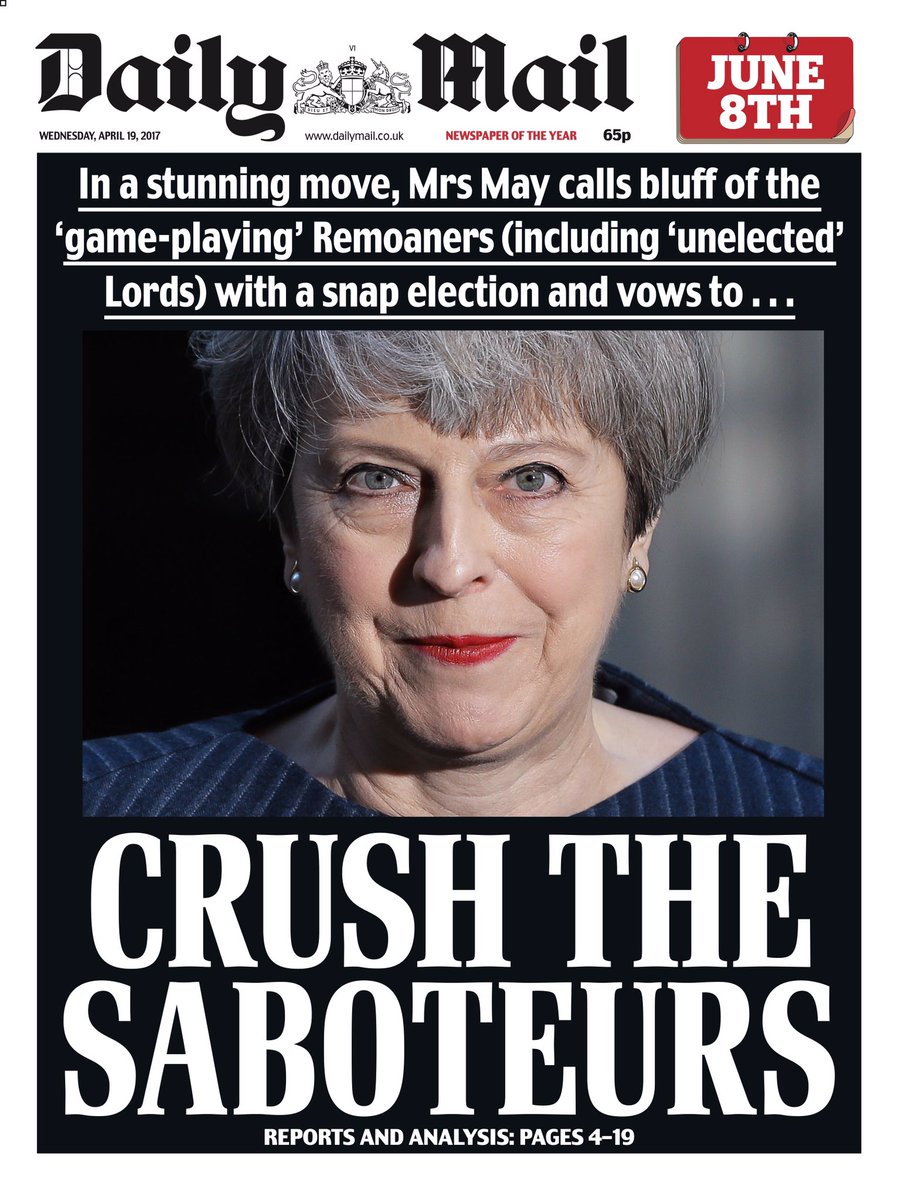
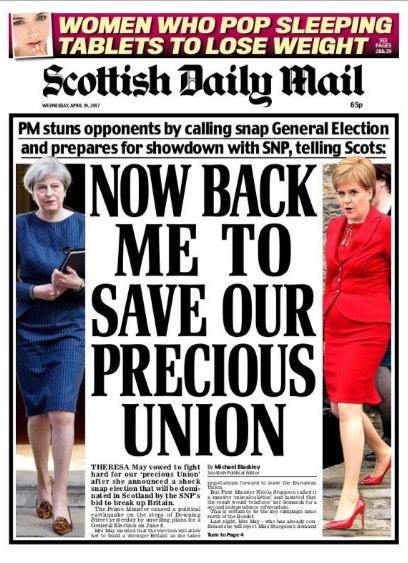
The Daily Mail meanwhile, set its election tone with the now infamous ‘Crush The Saboteurs’ front page – although it couldn’t quite bring itself to use the same headline the same day in its Scottish edition – and its desperation only grew as May’s campaign performances fizzled and the paper increasingly turned its fire on the opposition.
The day before the election, Buzzfeed’s Jim Waterson flicked – almost in disbelief – through the Mail and tweeted:
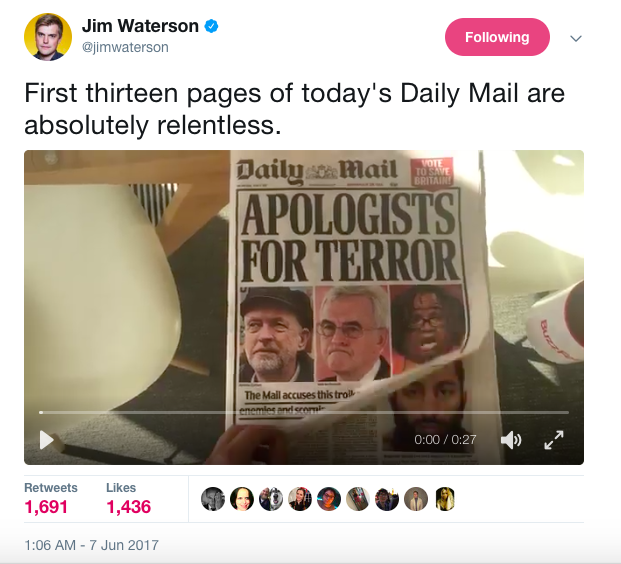
Link to original tweet (with video): https://twitter.com/jimwaterson/status/872364109458804736
In an excellent piece for The Observer Tim Adams traced the Mail’s coverage during the period from last year’s EU referendum to the calling of the election, and asked “Is the editor of the Daily Mail the most dangerous man in Britain?” while Kevin Maguire in the New Statesman offered a delicious election-night snapshot of the Mail newsroom:

On reflection it really didn’t take long for the paper’s tune to change as it looked for a scapegoat (as Private Eye points out) and turned to its traditional front-page distraction.

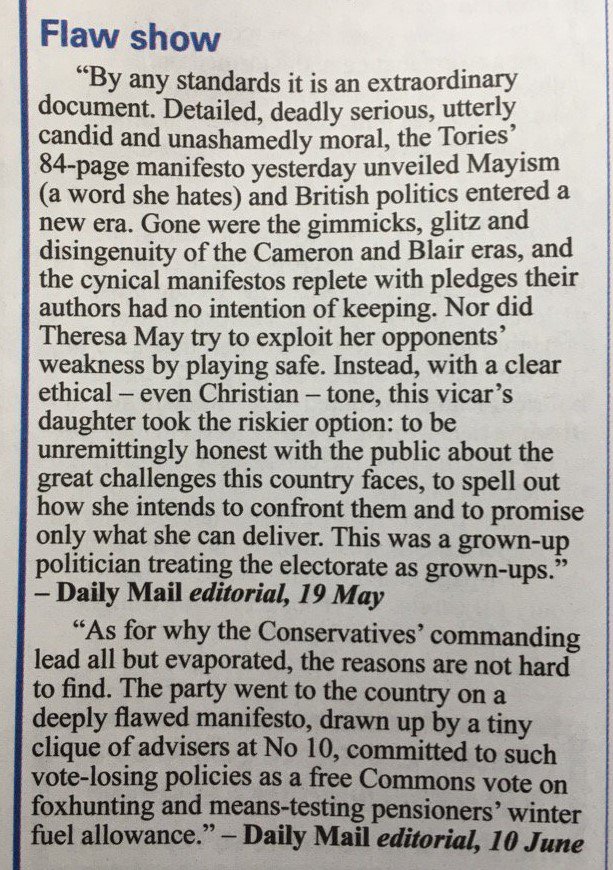
The Mail wasn’t alone that weekend, as papers across the spectrum turned on the PM, from the Sun’s “She’s had her chips” to The Times’ “May stares into abyss” – with the Thunderer saying in its editorial: “Mrs May is now fatally wounded. If she does not realise this it is another grave misjudgment. More likely, she is steeling herself to provide what continuity she can as her party girds itself for an election to replace her.”
Was it Facebook wot won it?
So has the influence of the traditional Tory press really become outdated, and is it being increasingly replaced by activity on social media? Or as the BBC wondered, was social merely reflecting rather than influencing, public opinion?
Jasper Jackson wrote in the New Statesman that “Corbyn’s success in the face of such vehement opposition from the media barons who have so successfully shaped UK politics – the Barclay Brothers, the Murdochs, the whirlwind of obscenity that is Mail editor Paul Dacre – seems hugely significant… It’s a low watermark the right-wing press, and perhaps even the Tories, may find it very difficult to recover from.”
The aforementioned Jim Waterson reflected that this was the election where newspapers “lost their monopoly on the political news agenda” and, writing about Buzzfeed’s analysis of political social media content during the campaign, said:
The hyperpartisan sites are creating their own parallel universe where a small number of policy topics – often of the sort that would be seen as too irrelevant for a mainstream news bulletin, such as fox hunting and NHS land disposals – are hammered home again and again, and then flood people’s Facebook feeds.
Clearly, there were many other media factors at work during the campaign and after; from May’s interview with a Plymouth paper that went viral, to former Chancellor George Osborne’s role as editor of the Evening Standard, to the growth of the anti-Brexit New European, to the ever-present anti-immigrant anger of the Daily Express.
But it’s the condition of the two main traditional Tory tabloids, the Mail and the Sun, with their combined daily print circulations of about 3 million, which have been a bellwether for sentiment on the country and those who lead it. And you can bet in their newsrooms they’ll be asking questions like these:
- Did they misjudge the mood beyond their core readership?
- Do younger readers now see them as irrelevant?
- And, crucially, will they do things any differently next time?
As Will Hutton wrote in The Guardian: “It is not the citizens’ fault that in desperation they feel their only reaction is to bin the papers that helped create this pretty pass. It is the proprietors and their editors who have so abused the role of journalism in a democracy. It has also become self-defeating.”
But regardless of the media’s fleeting and ephemeral headlines, or their photoshopped graphics designed for throwaway visual impact; as Theresa May searches for support in turbulent times, it is the very real image of Grenfell Tower, and an ill-judged initial response to it, that could eventually prove to be her ‘Katrina moment’.
Patrick Cockburn wrote in The Independent that:
As New Orleans was being engulfed, President George W Bush was on an extended holiday at his ranch in Crawford, Texas, where he remained for several days. He finally flew back to Washington on 31 August, his plane making a detour over the stricken city. It was a picture of him looking distant and disengaged as he viewed the wreckage of New Orleans that destroyed his reputation forever.
It is curious that Theresa May should make much the same mistake as Bush by not meeting survivors in Kensington while appearing cold and uninterested. Even the photo editors have turned against her and mostly chose to contrast her chilly appearance with a cuddly looking Jeremy Corbyn comforting a victim. She appears to be somebody who cannot handle pressure, which makes it look particularly odd of her and her advisers to have sought to win re-election as the unshakeable national leader. Corbyn, on the contrary, seems to thrive on crisis and adversity.
Also published on Medium.
